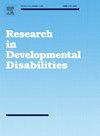Can the Stroop Test be useful in differentiating specific learning disorder from attention deficit hyperactivity disorder in medication-free children?
IF 2.6
2区 医学
Q1 EDUCATION, SPECIAL
引用次数: 0
Abstract
Introduction
Specific learning disorder (SLD) is a significant comorbidity in children with attention deficit hyperactivity disorder (ADHD). Identifying SLD in patients with ADHD is crucial because individualized educational interventions are the primary treatment for SLD. This study aimed to evaluate the utility of the Stroop Test (ST) in differentiating SLD from ADHD.
Methods
A total of 79 patients (42 with ADHD and 37 with ADHD and SLD) participated in the study. ST performance metrics (completion time, errors, and corrections) were collected by a child and adolescent psychiatrist. Additionally, parents completed the Turgay Diagnostic and Statistical Manual of Mental Disorders ADHD Rating Scale to assess the severity of ADHD symptoms.
Results
The ADHD+SLD group exhibited longer completion times across all sections of the ST. Errors in the third, fourth, and fifth sections were significantly higher in the ADHD+SLD group. After adjusting for age, gender, and ADHD symptom severity, the completion time in the fifth section remained significant. Receiver operating characteristic (ROC) analysis identified cut-off scores for the fifth section’s completion time (42 seconds; sensitivity: 0.62, specificity: 0.66) and errors (1 error; sensitivity: 0.64, specificity: 0.61). Moreover, errors in the fifth section predicted being in the ADHD+SLD group (p = .006, odds ratio [OR] = 1.527).
Conclusion
The findings suggest that the ST may be a valuable tool for diagnosing SLD in patients with ADHD. In particular, the completion time and errors in the fifth section of the ST may serve as useful tools in supporting the diagnostic process.
Stroop测试在区分无药物儿童的特殊学习障碍和注意缺陷多动障碍方面有用吗?
特异性学习障碍(SLD)是儿童注意缺陷多动障碍(ADHD)的重要合并症。识别ADHD患者的特殊障碍是至关重要的,因为个性化的教育干预是治疗特殊障碍的主要方法。本研究旨在评估Stroop测试(ST)在区分SLD和ADHD方面的效用。方法共79例患者(ADHD 42例,ADHD合并SLD 37例)参与研究。ST绩效指标(完成时间、错误和纠正)由儿童和青少年精神病学家收集。此外,家长完成了Turgay精神障碍诊断与统计手册ADHD评定量表,以评估ADHD症状的严重程度。结果ADHD+SLD组在所有st段的完成时间都更长,ADHD+SLD组第三、四、五段的错误明显高于ADHD+SLD组。在调整了年龄、性别和ADHD症状严重程度后,第五部分的完成时间仍然显著。受试者工作特征(ROC)分析确定了第五段完成时间的截止分数(42 秒;灵敏度:0.62,特异性:0.66)和误差(1个误差;敏感性:0.64,特异性:0.61)。此外,第五部分的错误预测ADHD+SLD组(p = )。006,优势比[OR] = 1.527)。结论ST可能是诊断ADHD患者SLD的一个有价值的工具。特别是,第五部分的完成时间和错误可以作为支持诊断过程的有用工具。
本文章由计算机程序翻译,如有差异,请以英文原文为准。
求助全文
约1分钟内获得全文
求助全文
来源期刊

Research in Developmental Disabilities
Multiple-
CiteScore
5.50
自引率
6.50%
发文量
178
期刊介绍:
Research In Developmental Disabilities is aimed at publishing original research of an interdisciplinary nature that has a direct bearing on the remediation of problems associated with developmental disabilities. Manuscripts will be solicited throughout the world. Articles will be primarily empirical studies, although an occasional position paper or review will be accepted. The aim of the journal will be to publish articles on all aspects of research with the developmentally disabled, with any methodologically sound approach being acceptable.
 求助内容:
求助内容: 应助结果提醒方式:
应助结果提醒方式:


